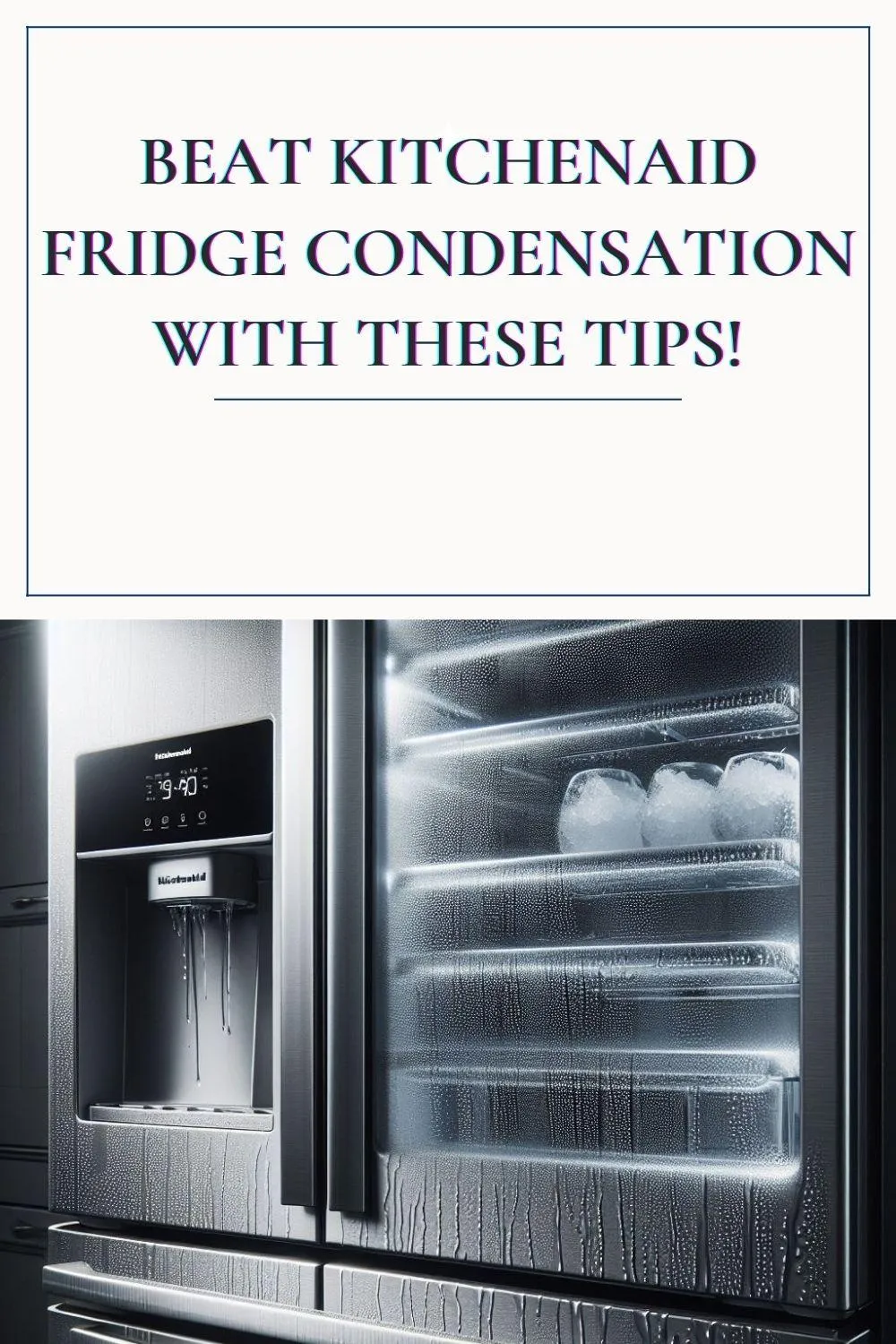THE FASTEST TOOLS IN TOWN
ZIP APPLIANCE REPAIR & SERVICE
Phone: (559) 272-4265
Phone: (559) 272-4265
Appliance Repair Tips For Fresno, CA Residents

Say Goodbye to Excess Moisture in Your KitchenAid Fridge!
“Embrace freshness, bid farewell to moisture. Say goodbye to excess moisture in your KitchenAid fridge!” - Appliance Boss
Introduction:
Welcome to a fresher fridge experience!
In the hustle and bustle of daily life, it's easy to overlook the importance of maintaining optimal conditions in your kitchen appliances. However, when it comes to your KitchenAid fridge, combating excess moisture is paramount for preserving food freshness and ensuring the longevity of your appliance. In this comprehensive guide, we'll explore the ins and outs of excess moisture in your fridge, its potential consequences, and effective strategies to keep your fridge moisture-free and your food at its best.

Understanding Excess Moisture:
Excess moisture in refrigerators can stem from a variety of sources, ranging from external environmental factors to internal appliance malfunctions. One common culprit is poor insulation, which allows warm, humid air to infiltrate the fridge and condense on its cooler surfaces. Additionally, faulty door seals or gaskets can create gaps through which moisture-laden air seeps into the fridge, leading to condensation and subsequent moisture buildup.
The risks associated with excessive moisture buildup in your KitchenAid fridge are multifaceted. Mold and mildew thrive in damp environments, posing health risks and compromising food safety. Moreover, water pooling can occur on shelves and in drawers, potentially damaging food packaging and causing leaks that can lead to further moisture-related issues. Additionally, excess moisture accelerates food spoilage by creating an environment conducive to bacterial growth, resulting in premature rotting and unpleasant odors permeating throughout the fridge.
Common signs of moisture problems in your KitchenAid fridge include visible water droplets on interior surfaces, especially along the walls and shelves, as well as frost buildup in the freezer compartment. Additionally, mold growth in corners and crevices, along with a persistent musty odor emanating from the appliance, are telltale indicators of excess moisture accumulation.
Consequences of Excess Moisture:
Mold growth is a pervasive issue in environments with high humidity levels, and your fridge is no exception. Mold spores present in the air can settle on damp surfaces within the fridge, such as rubber seals or leftover food residue, and proliferate rapidly under favorable conditions. Not only does mold compromise food safety by contaminating stored items, but it also poses health risks, particularly for individuals with allergies or respiratory conditions.
Water pooling may seem like a minor inconvenience at first glance, but its implications can be far-reaching. Pooled water can seep into the crevices of shelves and drawers, promoting bacterial growth and compromising the structural integrity of these components. Over time, this can lead to warping or corrosion, necessitating costly repairs or replacements.
Food spoilage is perhaps the most immediate consequence of excess moisture in your KitchenAid fridge. As moisture accumulates within the appliance, it creates an environment conducive to bacterial growth and enzymatic activity, hastening the decomposition of perishable food items. Fruits and vegetables may become wilted or mushy, while dairy and meat products may develop off-flavors or odors due to microbial contamination. In addition to the financial implications of wasted groceries, food spoilage can also contribute to household food insecurity and environmental waste.
Identifying Problem Areas:
Certain areas of your KitchenAid fridge are more susceptible to moisture buildup than others, making them prime targets for proactive maintenance and inspection. The crisper drawers, located at the bottom of the fridge, are particularly prone to condensation due to their proximity to the refrigerator's cooling coils. Likewise, the door seals or gaskets, which are responsible for maintaining an airtight seal when the fridge is closed, are common trouble spots where moisture infiltration can occur.
To effectively identify problem areas in your KitchenAid fridge, it's essential to be vigilant for signs of excess moisture accumulation. Visual cues, such as water droplets or frost formation on interior surfaces, are early indicators of potential issues. Additionally, pay attention to changes in the fridge's operating conditions, such as fluctuating temperature or humidity levels, which may signal underlying problems requiring attention.
Temperature and humidity play pivotal roles in the formation and mitigation of excess moisture in your KitchenAid fridge. Refrigerators operate by removing heat from the interior compartment and expelling it into the surrounding environment, thereby maintaining a cool and dry environment for food storage. However, fluctuations in temperature or humidity levels can disrupt this delicate balance, leading to condensation or moisture buildup within the appliance.
Preventive Maintenance Tips:
Keeping it cool: Optimal temperature settings are critical for reducing condensation and moisture buildup in your KitchenAid fridge. Aim to maintain a temperature range between 37°F and 40°F (2.8°C and 4.4°C) in the refrigerator compartment, while the freezer should be set at 0°F (-17.8°C) to ensure food safety and minimize the risk of excess moisture accumulation.
Seal the deal: Checking and replacing fridge gaskets on a regular basis is essential for preserving the integrity of your appliance's door seals. Over time, gaskets may become worn or damaged, resulting in gaps that allow warm air to enter the fridge and contribute to condensation. Inspect the gaskets for signs of wear, such as cracks or tears, and replace them as needed to maintain an airtight seal.
Ventilation matters: Ensuring proper airflow within your KitchenAid fridge is crucial for preventing moisture buildup and maintaining food freshness. Avoid overloading shelves or blocking air vents, as this can impede airflow and create pockets of stagnant air where condensation may occur. Additionally, periodically clean the fridge's condenser coils to remove dust and debris, which can obstruct airflow and compromise cooling efficiency.
Defrost regularly: Frost buildup in the freezer compartment is a common source of excess moisture in refrigerators. To prevent ice accumulation, defrost your KitchenAid fridge on a regular basis, ideally every six months or as needed depending on usage patterns. Follow the manufacturer's instructions for defrosting, which may involve manually melting accumulated ice using a hairdryer or scraper, or utilizing the appliance's built-in defrost cycle.
Keep it clean: Maintaining a hygienic environment inside your KitchenAid fridge is essential for preventing mold growth and foul odors. Regularly clean interior surfaces, including shelves, drawers, and walls, using a mixture of mild detergent and warm water. Pay special attention to crevices and hard-to-reach areas where moisture may accumulate, and thoroughly dry all surfaces after cleaning to prevent residual moisture from lingering.
DIY Solutions to Combat Excess Moisture:
Homemade dehumidifiers: Budget-friendly tricks to absorb moisture and maintain a dry environment in your KitchenAid fridge. Place bowls of activated charcoal or silica gel packs inside the appliance to help absorb excess moisture from the air. Alternatively, fill a small mesh bag with calcium chloride crystals, a highly hygroscopic compound that readily absorbs water vapor, and hang it inside the fridge to reduce humidity levels.
Baking soda magic: Utilizing this kitchen staple to fight odors and moisture in your KitchenAid fridge. Baking soda, or sodium bicarbonate, acts as a natural deodorizer and absorbs moisture from the air, helping to keep the fridge smelling fresh and dry. Simply place an open box of baking soda on a shelf or in the door compartment to neutralize odors and maintain optimal humidity levels.
Silica gel packs: Harnessing the moisture-absorbing properties of silica gel to combat excess moisture in your KitchenAid fridge. Silica gel, a desiccant commonly found in packaging materials, is highly effective at absorbing water vapor from the air, making it an ideal solution for reducing humidity levels in confined spaces such as refrigerators. Place several silica gel packs strategically around the fridge to help maintain a dry environment and prevent mold growth.
Charcoal power: Leveraging the deodorizing and dehumidifying properties of charcoal to keep your KitchenAid fridge fresh and moisture-free. Activated charcoal, derived from natural sources such as coconut shells or bamboo, acts as a porous adsorbent, trapping odors and moisture molecules within its structure. Place a few charcoal briquettes in a bowl or mesh bag and store them inside the fridge to help eliminate musty odors and maintain optimal humidity levels.
Advanced Solutions for Persistent Moisture Problems:
Installing a dedicated refrigerator dehumidifier is a more advanced solution for combating excess moisture in your KitchenAid fridge. These devices are specifically designed to remove moisture from the air inside the fridge, helping to maintain optimal humidity levels and prevent mold growth. Refrigerator dehumidifiers typically utilize desiccant materials or electronic cooling systems to absorb or condense water vapor, making them an effective long-term solution for moisture management.
Upgrading to a frost-free fridge eliminates the need for manual defrosting, reducing the risk of excess moisture buildup and associated problems. Frost-free fridges utilize advanced technology, such as automatic defrost cycles and evaporator fans, to prevent ice formation and maintain consistent temperature and humidity levels throughout the appliance. While frost-free models may be more expensive upfront, they offer convenience and peace of mind by minimizing maintenance requirements and preserving food freshness.
Consulting a professional appliance technician is advisable if you experience persistent moisture problems despite implementing preventive measures. A trained technician can perform a thorough inspection of your KitchenAid fridge to diagnose underlying issues such as refrigerant leaks, faulty components, or insulation deficiencies. Based on their assessment, they can recommend appropriate solutions, such as repairing or replacing defective parts, retrofitting the appliance with moisture management devices, or upgrading to a newer model with enhanced features.

Maintaining a Moisture-Free Fridge Long-Term:
Establishing regular inspection and maintenance routines is essential for preventing moisture buildup and ensuring the long-term performance of your KitchenAid fridge. Schedule bi-monthly checks to assess the condition of door seals, gaskets, and internal components, and address any issues promptly to prevent further damage or deterioration.
Organizing your fridge efficiently can help optimize airflow and prevent condensation and moisture buildup. Arrange food items strategically to allow for adequate ventilation and airflow throughout the appliance, avoiding overcrowding or blocking air vents. Additionally, store perishable items in airtight containers or sealed bags to minimize moisture transfer and preserve food freshness.
Staying vigilant and monitoring your fridge for signs of moisture problems is crucial for early detection and intervention. Keep an eye out for water droplets, frost formation, or mold growth on interior surfaces, and investigate any unusual odors or fluctuations in temperature or humidity levels. By promptly addressing emerging issues, you can prevent minor problems from escalating into major headaches and ensure the continued performance of your KitchenAid fridge.
Encouraging good habits and educating household members on proper fridge care and maintenance is essential for maintaining a moisture-free environment long-term. Remind family members to avoid leaving the fridge door open for extended periods, as this can allow warm air to enter the appliance and contribute to condensation. Additionally, emphasize the importance of promptly cleaning up spills and disposing of expired or spoiled food items to prevent mold growth and maintain a hygienic environment.
Conclusion:
Embrace freshness and bid farewell to excess moisture in your KitchenAid fridge with confidence, courtesy of Zip Appliance Repair and Service. By understanding the causes and consequences of moisture buildup and implementing proactive maintenance and preventive measures, you can enjoy a moisture-free environment and prolong the lifespan of your appliance. Remember to stay vigilant, organize your fridge efficiently, and educate household members on proper fridge care to ensure continued freshness and food safety for years to come.
Recap of key takeaways:
Excess moisture in your fridge can lead to mold growth, water pooling, and food spoilage, compromising food safety and appliance performance. Regular maintenance and DIY solutions such as homemade dehumidifiers can help combat moisture buildup and preserve food freshness. Consider advanced solutions like refrigerator dehumidifiers or upgrading to a frost-free fridge for persistent moisture problems that require professional intervention. Stay vigilant, organize your fridge efficiently, and educate household members on proper fridge care to maintain a moisture-free environment long-term.
For reliable appliance repair and service, visit Zip Appliance Repair and Service at fresno.ziprepairservice.com or call us at (661) 387-2282.

Say Goodbye to Excess Moisture in Your KitchenAid Fridge!
“Embrace freshness, bid farewell to moisture. Say goodbye to excess moisture in your KitchenAid fridge!” - Appliance Boss
Introduction:
Welcome to a fresher fridge experience!
In the hustle and bustle of daily life, it's easy to overlook the importance of maintaining optimal conditions in your kitchen appliances. However, when it comes to your KitchenAid fridge, combating excess moisture is paramount for preserving food freshness and ensuring the longevity of your appliance. In this comprehensive guide, we'll explore the ins and outs of excess moisture in your fridge, its potential consequences, and effective strategies to keep your fridge moisture-free and your food at its best.

Understanding Excess Moisture:
Excess moisture in refrigerators can stem from a variety of sources, ranging from external environmental factors to internal appliance malfunctions. One common culprit is poor insulation, which allows warm, humid air to infiltrate the fridge and condense on its cooler surfaces. Additionally, faulty door seals or gaskets can create gaps through which moisture-laden air seeps into the fridge, leading to condensation and subsequent moisture buildup.
The risks associated with excessive moisture buildup in your KitchenAid fridge are multifaceted. Mold and mildew thrive in damp environments, posing health risks and compromising food safety. Moreover, water pooling can occur on shelves and in drawers, potentially damaging food packaging and causing leaks that can lead to further moisture-related issues. Additionally, excess moisture accelerates food spoilage by creating an environment conducive to bacterial growth, resulting in premature rotting and unpleasant odors permeating throughout the fridge.
Common signs of moisture problems in your KitchenAid fridge include visible water droplets on interior surfaces, especially along the walls and shelves, as well as frost buildup in the freezer compartment. Additionally, mold growth in corners and crevices, along with a persistent musty odor emanating from the appliance, are telltale indicators of excess moisture accumulation.
Consequences of Excess Moisture:
Mold growth is a pervasive issue in environments with high humidity levels, and your fridge is no exception. Mold spores present in the air can settle on damp surfaces within the fridge, such as rubber seals or leftover food residue, and proliferate rapidly under favorable conditions. Not only does mold compromise food safety by contaminating stored items, but it also poses health risks, particularly for individuals with allergies or respiratory conditions.
Water pooling may seem like a minor inconvenience at first glance, but its implications can be far-reaching. Pooled water can seep into the crevices of shelves and drawers, promoting bacterial growth and compromising the structural integrity of these components. Over time, this can lead to warping or corrosion, necessitating costly repairs or replacements.
Food spoilage is perhaps the most immediate consequence of excess moisture in your KitchenAid fridge. As moisture accumulates within the appliance, it creates an environment conducive to bacterial growth and enzymatic activity, hastening the decomposition of perishable food items. Fruits and vegetables may become wilted or mushy, while dairy and meat products may develop off-flavors or odors due to microbial contamination. In addition to the financial implications of wasted groceries, food spoilage can also contribute to household food insecurity and environmental waste.
Identifying Problem Areas:
Certain areas of your KitchenAid fridge are more susceptible to moisture buildup than others, making them prime targets for proactive maintenance and inspection. The crisper drawers, located at the bottom of the fridge, are particularly prone to condensation due to their proximity to the refrigerator's cooling coils. Likewise, the door seals or gaskets, which are responsible for maintaining an airtight seal when the fridge is closed, are common trouble spots where moisture infiltration can occur.
To effectively identify problem areas in your KitchenAid fridge, it's essential to be vigilant for signs of excess moisture accumulation. Visual cues, such as water droplets or frost formation on interior surfaces, are early indicators of potential issues. Additionally, pay attention to changes in the fridge's operating conditions, such as fluctuating temperature or humidity levels, which may signal underlying problems requiring attention.
Temperature and humidity play pivotal roles in the formation and mitigation of excess moisture in your KitchenAid fridge. Refrigerators operate by removing heat from the interior compartment and expelling it into the surrounding environment, thereby maintaining a cool and dry environment for food storage. However, fluctuations in temperature or humidity levels can disrupt this delicate balance, leading to condensation or moisture buildup within the appliance.
Preventive Maintenance Tips:
Keeping it cool: Optimal temperature settings are critical for reducing condensation and moisture buildup in your KitchenAid fridge. Aim to maintain a temperature range between 37°F and 40°F (2.8°C and 4.4°C) in the refrigerator compartment, while the freezer should be set at 0°F (-17.8°C) to ensure food safety and minimize the risk of excess moisture accumulation.
Seal the deal: Checking and replacing fridge gaskets on a regular basis is essential for preserving the integrity of your appliance's door seals. Over time, gaskets may become worn or damaged, resulting in gaps that allow warm air to enter the fridge and contribute to condensation. Inspect the gaskets for signs of wear, such as cracks or tears, and replace them as needed to maintain an airtight seal.
Ventilation matters: Ensuring proper airflow within your KitchenAid fridge is crucial for preventing moisture buildup and maintaining food freshness. Avoid overloading shelves or blocking air vents, as this can impede airflow and create pockets of stagnant air where condensation may occur. Additionally, periodically clean the fridge's condenser coils to remove dust and debris, which can obstruct airflow and compromise cooling efficiency.
Defrost regularly: Frost buildup in the freezer compartment is a common source of excess moisture in refrigerators. To prevent ice accumulation, defrost your KitchenAid fridge on a regular basis, ideally every six months or as needed depending on usage patterns. Follow the manufacturer's instructions for defrosting, which may involve manually melting accumulated ice using a hairdryer or scraper, or utilizing the appliance's built-in defrost cycle.
Keep it clean: Maintaining a hygienic environment inside your KitchenAid fridge is essential for preventing mold growth and foul odors. Regularly clean interior surfaces, including shelves, drawers, and walls, using a mixture of mild detergent and warm water. Pay special attention to crevices and hard-to-reach areas where moisture may accumulate, and thoroughly dry all surfaces after cleaning to prevent residual moisture from lingering.
DIY Solutions to Combat Excess Moisture:
Homemade dehumidifiers: Budget-friendly tricks to absorb moisture and maintain a dry environment in your KitchenAid fridge. Place bowls of activated charcoal or silica gel packs inside the appliance to help absorb excess moisture from the air. Alternatively, fill a small mesh bag with calcium chloride crystals, a highly hygroscopic compound that readily absorbs water vapor, and hang it inside the fridge to reduce humidity levels.
Baking soda magic: Utilizing this kitchen staple to fight odors and moisture in your KitchenAid fridge. Baking soda, or sodium bicarbonate, acts as a natural deodorizer and absorbs moisture from the air, helping to keep the fridge smelling fresh and dry. Simply place an open box of baking soda on a shelf or in the door compartment to neutralize odors and maintain optimal humidity levels.
Silica gel packs: Harnessing the moisture-absorbing properties of silica gel to combat excess moisture in your KitchenAid fridge. Silica gel, a desiccant commonly found in packaging materials, is highly effective at absorbing water vapor from the air, making it an ideal solution for reducing humidity levels in confined spaces such as refrigerators. Place several silica gel packs strategically around the fridge to help maintain a dry environment and prevent mold growth.
Charcoal power: Leveraging the deodorizing and dehumidifying properties of charcoal to keep your KitchenAid fridge fresh and moisture-free. Activated charcoal, derived from natural sources such as coconut shells or bamboo, acts as a porous adsorbent, trapping odors and moisture molecules within its structure. Place a few charcoal briquettes in a bowl or mesh bag and store them inside the fridge to help eliminate musty odors and maintain optimal humidity levels.
Advanced Solutions for Persistent Moisture Problems:
Installing a dedicated refrigerator dehumidifier is a more advanced solution for combating excess moisture in your KitchenAid fridge. These devices are specifically designed to remove moisture from the air inside the fridge, helping to maintain optimal humidity levels and prevent mold growth. Refrigerator dehumidifiers typically utilize desiccant materials or electronic cooling systems to absorb or condense water vapor, making them an effective long-term solution for moisture management.
Upgrading to a frost-free fridge eliminates the need for manual defrosting, reducing the risk of excess moisture buildup and associated problems. Frost-free fridges utilize advanced technology, such as automatic defrost cycles and evaporator fans, to prevent ice formation and maintain consistent temperature and humidity levels throughout the appliance. While frost-free models may be more expensive upfront, they offer convenience and peace of mind by minimizing maintenance requirements and preserving food freshness.
Consulting a professional appliance technician is advisable if you experience persistent moisture problems despite implementing preventive measures. A trained technician can perform a thorough inspection of your KitchenAid fridge to diagnose underlying issues such as refrigerant leaks, faulty components, or insulation deficiencies. Based on their assessment, they can recommend appropriate solutions, such as repairing or replacing defective parts, retrofitting the appliance with moisture management devices, or upgrading to a newer model with enhanced features.

Maintaining a Moisture-Free Fridge Long-Term:
Establishing regular inspection and maintenance routines is essential for preventing moisture buildup and ensuring the long-term performance of your KitchenAid fridge. Schedule bi-monthly checks to assess the condition of door seals, gaskets, and internal components, and address any issues promptly to prevent further damage or deterioration.
Organizing your fridge efficiently can help optimize airflow and prevent condensation and moisture buildup. Arrange food items strategically to allow for adequate ventilation and airflow throughout the appliance, avoiding overcrowding or blocking air vents. Additionally, store perishable items in airtight containers or sealed bags to minimize moisture transfer and preserve food freshness.
Staying vigilant and monitoring your fridge for signs of moisture problems is crucial for early detection and intervention. Keep an eye out for water droplets, frost formation, or mold growth on interior surfaces, and investigate any unusual odors or fluctuations in temperature or humidity levels. By promptly addressing emerging issues, you can prevent minor problems from escalating into major headaches and ensure the continued performance of your KitchenAid fridge.
Encouraging good habits and educating household members on proper fridge care and maintenance is essential for maintaining a moisture-free environment long-term. Remind family members to avoid leaving the fridge door open for extended periods, as this can allow warm air to enter the appliance and contribute to condensation. Additionally, emphasize the importance of promptly cleaning up spills and disposing of expired or spoiled food items to prevent mold growth and maintain a hygienic environment.
Conclusion:
Embrace freshness and bid farewell to excess moisture in your KitchenAid fridge with confidence, courtesy of Zip Appliance Repair and Service. By understanding the causes and consequences of moisture buildup and implementing proactive maintenance and preventive measures, you can enjoy a moisture-free environment and prolong the lifespan of your appliance. Remember to stay vigilant, organize your fridge efficiently, and educate household members on proper fridge care to ensure continued freshness and food safety for years to come.
Recap of key takeaways:
Excess moisture in your fridge can lead to mold growth, water pooling, and food spoilage, compromising food safety and appliance performance. Regular maintenance and DIY solutions such as homemade dehumidifiers can help combat moisture buildup and preserve food freshness. Consider advanced solutions like refrigerator dehumidifiers or upgrading to a frost-free fridge for persistent moisture problems that require professional intervention. Stay vigilant, organize your fridge efficiently, and educate household members on proper fridge care to maintain a moisture-free environment long-term.
For reliable appliance repair and service, visit Zip Appliance Repair and Service at fresno.ziprepairservice.com or call us at (661) 387-2282.
If your dryer has been giving you problems, contact Zip Appliance Repair & Service at (559) 272-4265

Appliance Repair In A Zip
If you need a dryer repair call our Team at (559) 272-4265, or visit our online scheduling page to request service.
Appliance Repair
HAVE A QUESTION, CALL (559) 272-4265

Online Offers
Take advantage of our online discount offers - save time and money...

Residential & Commercial appliances
See what our company can do for you

Appliance Repair Tips
If your appliance is not working properly...

1405 Commercial Way ste 100
Bakersfield, CA 93309
Lic # 1116346
Equipment We Sevice
- A Call To Confirm Your Appointment Time
- A Email Detailing Your Assigned Technician
- Information Needed Before The Repair Can Be Started
- An Estimate Of Work To Be Done
© 2025 ZIP APPLIANCE REPAIR & SERVICE LLC







